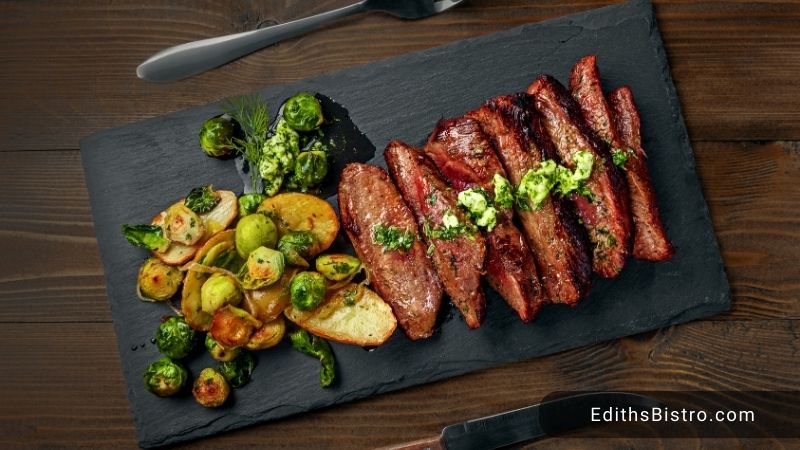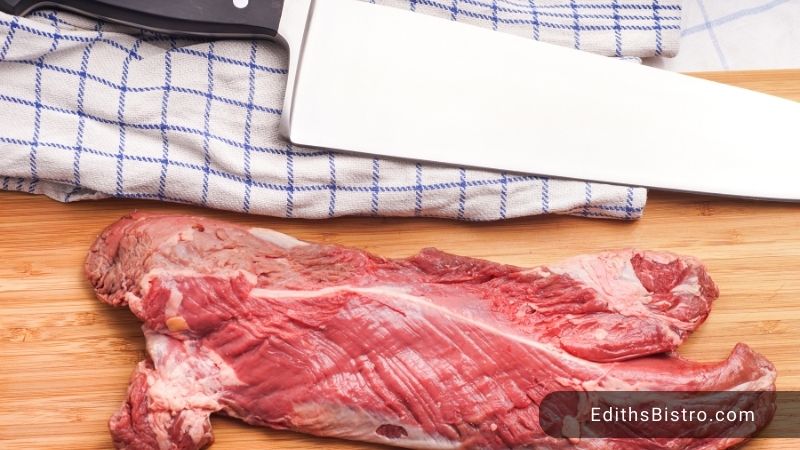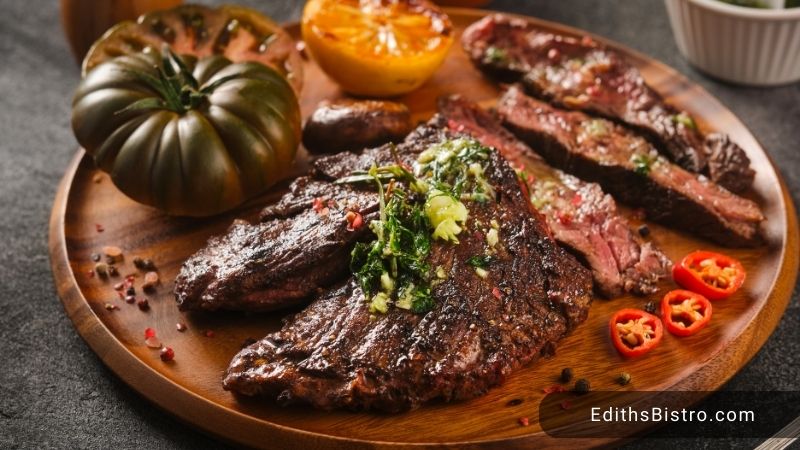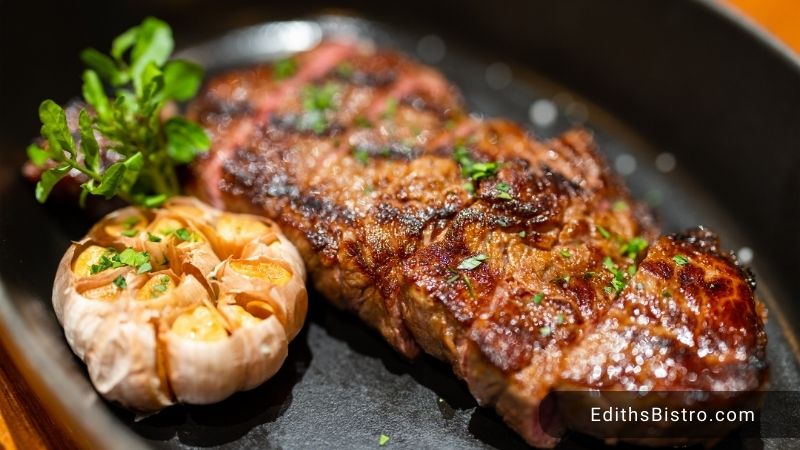In this comprehensive guide, we delve into the world of what is hanger steak, a unique cut of beef with a robust flavor and a distinctive texture. We explore its characteristics, and its comparison with other cuts like the skirt steak, and provide tips on where to buy and how to cook this relatively rare yet affordable cut.
What Is Hanger Steak?
Hanger steak, also known as the butcher’s steak, is a prized cut of beef that gets its name from the fact that it “hangs” from the diaphragm of the cow.
This unique position means there’s only one of these cuts per cow, making it somewhat rare. This cut is rich in flavor and has a distinctively coarse texture that sets it apart from other steaks.

Is hanger steak expensive?
Despite its rarity, hanger steak is not particularly expensive. It’s a relatively budget-friendly cut of beef, especially when compared to pricier cuts such as ribeye or filet mignon. This affordability, combined with its robust flavor, makes it a favorite among savvy gourmands.
Is hanger steak tender?
The tenderness of hanger steak is a bit of a paradox. Because it comes from a muscle that doesn’t get much exercise, it’s inherently tender. However, its unique grain structure can make it seem tougher if it’s not properly prepared. The key to achieving maximum tenderness is to cook it to medium-rare and slice it against the grain.
Is hanger steak fatty?
Hanger steak isn’t particularly fatty, but it has a high level of marbling. These thin veins of fat melt during cooking, imparting a rich, beefy flavor that’s both robust and satisfying.
Other names for hanger steak

Besides being known as the butcher’s steak, hanger steak goes by a few other names. It’s sometimes called the “bistro steak“, a nod to its popularity in French bistros. In French, it’s referred to as “onglet“.
What is hanger steak called in the grocery store?
If you’re looking for hanger steak in a grocery store, you might find it labeled as “hanging tenderloin“. Some stores may also label it under its French name, “onglet”. It’s worth noting that it might not be available in all stores due to its rarity.
Where To Buy Hanger Steak?
Your best bet for finding hanger steak or flat steak is at a butcher shop or a high-end grocery store. You can also find it at some online meat purveyors. If it’s not readily available, don’t hesitate to ask your butcher. They can often special order it for you.
There are a few places you can check.
- Local Butcher Shop: This is your best bet. A butcher shop will often have a wider variety of cuts than a standard grocery store. Plus, you can ask the butcher directly for hanger steak.
- High-End Grocery Stores: Upscale grocery stores or supermarkets with a good meat section might carry hanger steak. Don’t be shy to ask the staff if you can’t find it.
- Online Meat Retailers: Websites specializing in meat delivery often have a range of cuts available, including hanger steak. Examples include Omaha Steaks or ButcherBox.
- Farmers Markets: If you have a local farmers market where ranchers sell their products, you might find hanger steak there. It’s a great opportunity to support local businesses.
Remember, if you can’t locate hanger steak, ask!
Hanger Steak vs. Skirt Steak Or Flank Steak
Hanger steak is often compared to skirt steak due to its similar textures and robust flavors. However, they come from different parts of the cow.
Flank and Skirt steak comes from the cow’s diaphragm muscles, while hanger steak comes from the upper belly. While both are flavorful and relatively tender, hanger steak is generally considered to be the more premium cut.
Key differences between these two cuts:
- Origin: Hanger steak “hangs” from the cow’s diaphragm, hence its name. Skirt steak, on the other hand, comes from the cow’s belly muscles.
- Taste and Texture: Both steaks are known for their rich, beefy flavor. However, hanger steak is often seen as more tender and juicy than skirt steak.
- Cooking Method: Both cuts are great for grilling, broiling, and pan-searing. They’re best cooked to medium-rare and sliced against the grain for maximum tenderness.
- Use in Dishes: Skirt steak is often used in fajitas and stir-fry dishes due to its strong flavor. Hanger steak, with its tender texture, is perfect for dishes like steak frites or other recipes where the steak is the star.
In a nutshell, both hanger and skirt steak offer great texture and flavor for relatively affordable beef steaks. However, if you prefer a more tender steak, a hanger might be your best bet – it does not need much tenderize.
What Is Hanger Steak Best For? Sear or No Sear?
Hanger steak is highly versatile and can be used in a variety of dishes. It’s best when it’s quickly seared over high heat to medium-rare doneness. This locks in the juices and preserves their tender texture. Because of its robust flavor, it’s also excellent for marinating – you can add your favorite spices to your marinade. You might find it in dishes like steak frites, tacos, or even Asian stir-fries.

About searing: Yes, you should sear your hanger steak. Here’s why:
Searing the steak over high heat creates a beautiful crust on the outside. This doesn’t just look good; it also locks in the steak’s juices, keeping it tender – not chewy and juicy on the inside.
For best results, you should sear your hanger steak to a medium-rare doneness. This means cooking it for about 4-5 minutes on each side over high heat. Then, let it rest for a few minutes before slicing it against the grain.
How To Cook Hanger Steak – Best Hanger Steak Recipe

Ingredients
- 1 hanger steak about 1 lb
- 2 tablespoons olive oil
- 2 cloves garlic minced
- Salt and pepper to taste
- Fresh herbs like rosemary or thyme, optional
Instructions
- Preparation: Remove the steak from the fridge and let it come to room temperature. This takes about 30 minutes. While waiting, mince the garlic and prepare your herbs.
- Marinate: Rub the steak with olive oil, minced garlic, salt, and pepper. If using herbs, add them now. Let the steak marinate for at least 30 minutes. If you have more time, marinate it in the fridge for up to 24 hours.
- Cook: Preheat your skillet over high heat. Add the steak and sear for about 4-5 minutes on each side for medium-rare. Use a thermometer to make sure. Adjust the time depending on your preferred doneness.
- Rest: Remove the steak from the skillet and let it rest for about 10 minutes. This allows the juices to be redistributed throughout the steak.
- Serve: Slice the steak against the grain into thin strips. Serve immediately with your favorite sides.
While this is the traditional route for the butcher steak, there are many ways to cook hanger steaks and they all focus on its beefy flavors.
Frequently Asked Questions
What is hanger steak called in Your Country?
In Canada, hanger steak is often referred to as “flap meat” or “flap steak”. In Australia, hanger steak is sometimes known as “skirt steak.” And in the UK, hanger steak is often referred to as “skirt”, which, again, can lead to confusion with the American cut called skirt steak.
Is hanger steak like ribeye?
While hanger steak and ribeye both deliver on flavor, they’re quite different. Ribeye is more tender and has a higher fat content, while hanger steak is leaner with a coarser texture.
Is hanger steak a cheap cut?
Compared to premium cuts like ribeye or filet mignon, hanger steak is relatively inexpensive. However, its price can vary depending on where you buy it.
Conclusion
Hanger steak, the “butcher’s secret”, is a unique and flavorful cut that offers great value for money. Whether you’re preparing a simple seared steak or a marinated masterpiece, it’s a versatile addition to any menu. There’s a reason why it’s a staple in French bistros and a favorite of butchers everywhere – its robust flavor and tender texture are hard to beat. So why not give it a try and discover this hidden gem for yourself? Happy cooking!
References:
- Hanger steak: https://en.wikipedia.org/wiki/Hanger_steak
- Skirt steak: https://en.wikipedia.org/wiki/Skirt_steak






![What To Pair With Quiche? 25+ Best Dishes [With Pictures]](https://www.edithsbistro.com/wp-content/uploads/2024/04/what-to-pair-with-quiche-160x90.jpg)
